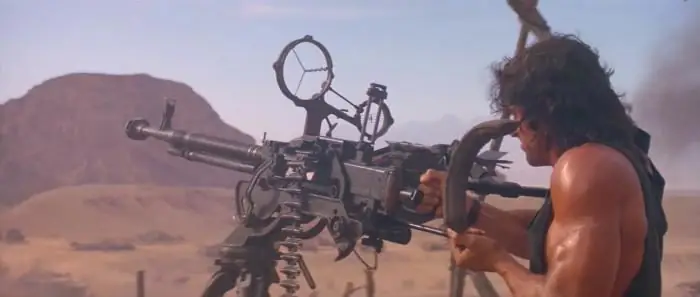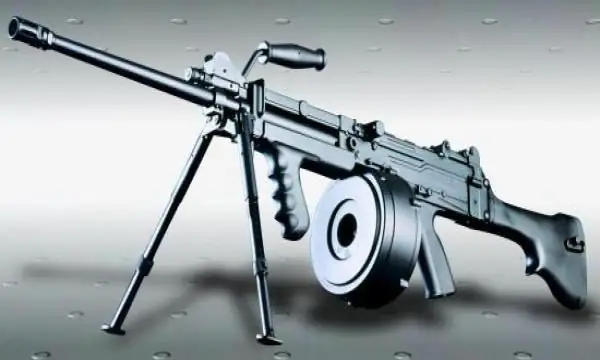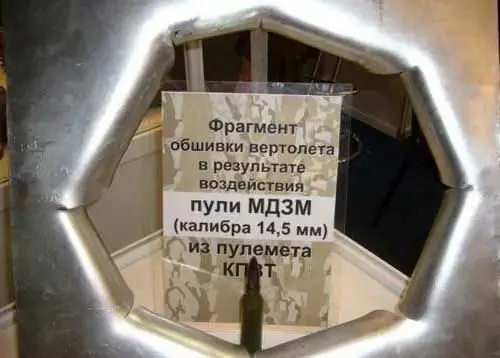2026 Author: Howard Calhoun | [email protected]. Last modified: 2025-01-24 13:10:31
Machine guns at the time of their appearance were not accidentally classified as artillery: the power of such weapons still amazes. Moreover, heavy "machine gunners" allow even mounted shooting, so that they can be attributed to artillery systems, albeit with tension, even today. As well as possible, this thesis is confirmed by the legendary NSVT machine gun, also known as the Utes.
Basic information and purpose

Refers to large-caliber barrels (12.7 mm). Created for the following purposes:
- Suppression and destruction of firing points, as well as lightly armored vehicles.
- Work on clusters of light equipment and enemy manpower at a distance of up to one and a half to two kilometers.
- Possibility of use as a means of air defense, to destroy targets flying at an altitude of up to one and a half kilometers.
The powerful Soviet cartridge 12, 7x108 made it possible to perform a whole range of different tasks, as it was produced in different variations (including also standard and armor-piercing bullets):
- Armor-piercing incendiary.
- Trace-armor-piercing-incendiary.
- Special incendiary, instant action.
How was this machine gun created?

Work on the creation of a new machine gun was started in the early 60s of the last century, since by that time it was finally necessary to completely replace the obsolete DShK (DShKM). By the way, later the team of authors also took part in the competition for the creation of a single machine gun of caliber 7, 62x54, but then Kalashnikov won.
By the way, where does the name "NSVT-machine gun" come from? The decoding is simple, since this is an abbreviation made up of the first letters of the names of the creators of this weapon: Nikitin, Sokolov, Volkov. The index "T" stands for "tank", but often the infantry version is also called that.
Specially for the production of new weapons from scratch, a plant was built in the city of Uralsk. Many workers moved there, and from the "weapons" cities: Tula, Izhevsk and Kovrov. Together they managed to create a completely unique weapon technology that had not been used anywhere until that day:
- The rifling was obtained by electrochemical, not mechanical, processing. This made it possible to minimize the likelihood of microscopic damage to the barrel, to increase the period of its use by several times.
- Thermal tempering was carried out in a vacuum chamber, which made it possible to achieve uniform hardening, without defects.
- Inkjet chromium plating of the entire barrel channel also greatly increased its combat survivability.
In the process of construction and the first fieldtests in the design of the "Cliff" was made many changes, most of them aimed at increasing the combat survivability of weapons, as well as its maximum simplification.
Places of production

In addition to the USSR, the NSVT machine gun was produced in India, Bulgaria and Poland. By the way, the license for Utes was transferred to them along with the right to manufacture the T-72 tank. It is known that Iran also received a similar permit, but, apparently, it did not work out to establish a complex production of machine guns on its territory.
Combat use
For the first time, the NSVT machine gun was successfully tested in Afghanistan. In the first months of the war, both sides of the conflict used exclusively the DShK (the Dushmans had Chinese copies). But soon our troops began to en masse move to the Utyos. Its great advantage was a simple fire control system, accuracy and accuracy.
If our soldiers spotted the Afghans approaching the outpost, their plans changed dramatically, since it was unrealistic to approach the distance of aimed fire from a machine gun to the checkpoint where the NSVT machine gun stood. Initially, a tank version on the machine was used for these purposes, but later a purely infantry modification also went to the troops.
Soon this weapon was firmly "rooted" on all types of Soviet tanks, self-propelled guns, and other armored vehicles. They also fell in love with the NSVT (machine gun) in the navy, where it was massively installed on patrol boats as a simple and effective means of self-defense, including against low-flying enemy aircraft.
Key Benefits
In both Chechen campaigns, the machine gun also showed its best side. Moreover, it was there that "Utes" acquired the nickname "anti-sniper". Since this weapon allows you to fire at a distance of up to two kilometers without any problems, militant snipers were simply ground together with shelters. But our fighters appreciated this technique even more when they finally began to supply normal sights to the troops:
- Standard, CPP brand.
- Night NSPU-3.
- A unique radar sight that made it possible to fire with exceptional accuracy even in complete darkness, when conventional "night lights" become almost useless due to exposure.

Of course, at the end of the 80s, the need to replace the Utes with something more modern was already acute, but it is still in service with our army. But the replacement of the machine gun is really worthy - "Kord" produced by the legendary Kovrov Arms Plant. Why was the NSVT so good from a constructive point of view? This machine gun is a whole "collection" of unique technical developments, in many ways ahead of its time.
Design Features
First, its weight. Only 25 kilograms! For machine guns of this caliber, this is still the minimum achievable weight, despite all the achievements of materials science. Automation "Cliff" - classic, based on the removal of powder gases. The barrel is locked by means of a wedge gate, and its earring at this time hits the striker. So elegant and simple solutiongreatly simplified the design of the weapon.
The trigger mechanism is also as simple as possible and allows only automatic fire. At the same time, a “block” can be connected to the weapon either with a trigger, or with an electric drive (on tanks). No reload handle.
Virtually all moving internal parts are fitted with rollers designed to minimize friction as much as possible. To increase the survivability of mechanics, a “fat” cadmium coating is applied to it. Thanks to a well-thought-out assembly and disassembly scheme, the replacement of the barrel could be easily carried out right in the field, in the shortest possible time. For ease of replacement, a handle is provided on the barrel. On the muzzle there is a flame arrester of a characteristic conical shape, which was borrowed from the DShK.

Are there any differences in the "armored" NSVT? A tank machine gun in its design is no different from a simple infantry variety, with the exception of the trigger. In its role is the simplest coil with a winding and a retractable rod. When current is applied to the device, the latter begins to move, pressing on the "trigger". Since the design is simple to the point of primitivism, it is extremely reliable, because there is nothing to break.
The shutter frame with the gas piston and the shutter are pivotally connected. Ammunition - by means of metal tapes, right and left feeding options are possible. An exclusive feature of the "Cliff" is the front ejection of spent cartridges, which allows you to use this weapon to create twin machine gun mounts. ATin particular, such ones were once produced in Tula. The effectiveness of the twin "Cliffs" is not much inferior to that of even the Shilka, although the rate of fire of the latter, of course, is higher.
Sighting mechanisms and machine gun ammunition
As sighting devices there is a front sight and a folding bar, marked up to a distance of two kilometers. Initially, the front sight was also folding, but practice has shown that there is no sense in such a design.
Ammunition supply from tapes with a "crab" hitch type. Each piece consists of ten links. The design is such that it is possible to assemble a tape of any arbitrary length (but not less than ten rounds, respectively). It is collapsible, if necessary, the pieces quickly disengage. A white stripe is applied along the longitudinal edge of the locking joints, so that in combat conditions one does not have to think for a long time where exactly to attach additional pieces.
Machine

In the infantry variant, the NSVT "Utes" machine gun is used from a 6T7 machine gun. The machine is thought out, provides excellent positional adaptability, allowing aimed fire from various positions. For the convenience of the shooter, a spring-loaded shoulder rest is designed, which significantly softens the recoil.
The infantry machine is not intended for anti-aircraft fire. Thanks to this, its design is as simple as possible, and the weight is 18 kilograms. In the transport position of 12, 7 mm, the NSVT machine gun is removed from it, and the machine itself folds up and can be carried by hand.
Modifications
The main modification isjust the same NSVT, which was installed on all Soviet tanks, starting with the later versions of the T-64, as well as other armored vehicles and coast guard boats. It was on the basis of this weapon that the Utes-M ship turret was created.
Interesting fact: the NSV 12.7 mm heavy machine gun was once actively used by the Finns, who put it on their armored personnel carriers operating as part of the UN missions in North Africa. They liked the reliability, simplicity and huge killing power of the Utes. Whether the NSV is currently in service with the Finnish army is unknown. However, this is quite possible, since a huge number of barrels could remain in Ukrainian warehouses, from where the Utyos were massively dispersed around the world at one time.
Why is the army switching to Kord today?
Why have our troops been switching to Kord lately? After all, the main performance characteristics of the NSVT / Kord machine gun are almost the same:
- Caliber 12.7mm.
- The range of aimed fire at ground targets is from one and a half to two kilometers.
- For air targets - up to one and a half kilometers.
- Rate of fire - 700-800 rounds per minute.

There is a simple explanation for this. The fact is that after the collapse of the USSR, the factories for the production of these weapons remained on the territory of Ukraine and Kazakhstan. For this reason, it was decided to develop their own Kord machine gun. It retained all the strengths of its predecessor, but greatly outperformed it in many ways.
Recommended:
Large-caliber machine guns of Russia and the world. Comparison of heavy machine guns

Even in the First World War, a fundamentally new and terrible weapon appeared on the battlefield. Large-caliber machine guns. In those years, there was no armor that could protect against them, and the shelters that were traditionally used by the infantry (made of earth and wood) generally made their way through with heavy bullets
Diesel gun: reviews and selection criteria. Diesel gun of indirect heating: technical characteristics

The diesel heat gun is ideal for quickly heating a construction site, agricultural, warehouse or industrial premises. Since its operation is carried out on diesel fuel, it consumes electricity exclusively for the operation of automation and a fan. As the main advantages of such a technological solution, one can name a relatively high thermal power with rather small dimensions
Browning machine gun: description, characteristics, photo

The Browning heavy machine gun is one of the few small guns that remains in service with the US Army to this day, having undergone minor modifications. It will be discussed in this article
RPK-16 machine gun: specifications. Kalashnikov light machine gun

At the international presentation of weapons "Army-2016", held in September 2016, the RPK-16 machine gun, the brainchild of domestic gunsmiths, was demonstrated. It will be discussed in this article
KPVT, machine gun. Heavy machine gun Vladimirov KPV

The idea of defeating aircraft and lightly armored vehicles led to the creation of heavy machine guns with a caliber of more than 12 mm. Such machine guns were already able to hit a lightly armored target, get a low-flying aircraft or helicopter, as well as shelters behind which there was infantry. According to the classification of small arms, the 14.5-mm KPVT machine gun is already adjacent to artillery weapons. And in design, heavy machine guns have much in common with automatic guns

